History of Cameroon
| History of Cameroon | ||
|---|---|---|
 | ||
| Pre-colonial | ||
| Colonial | ||
|
||
| Post-colonial | ||
|
||
|
| ||
At the crossroads of
European traders arrived in the fifteenth century and Cameroon was the
.Cameroon as a political entity emerged from the
In January 2024, Cameroon launched the world's first routine malaria vaccine program, using the World Health Organization (WHO)-approved RTS,S vaccine developed by British drugmaker GSK. The initiative aims to save thousands of African children's lives annually. Despite some skepticism, health experts emphasize careful community outreach to combat vaccine hesitancy and stress the importance of using existing preventive measures alongside vaccines.[2]
Pre-colonial history
Prehistory



Archaeological research has been relatively scarce in Cameroon due to a lack of resources and transportation infrastructure. Historically the warm, wet climate in many parts of the country was thought of as inhospitable to the preservation of remains, but recent finds and the introduction of new techniques have challenged that assumption. Evidence from digs at Shum Laka in the Northwest Region shows human occupation dating back 30,000 years[3][4] while in the dense forests of the south, the oldest evidence of occupation is around 7000 years old.[5] Recent research in southern Cameroon indicates that the Iron Age may have started there as early as 1000 BCE and was certainly well established by 100 BCE at the latest.[5]
Linguistic analysis, supported by archaeological and genetic research, has shown that the
Northern Cameroon
The earliest known civilization to have left clear traces of their presence in the territory of modern Cameroon is known as the
After the
From 1804 to 1808 the
Southern Regions
The Muslim empires of the Sahara and Sahel never reached further south than the highlands of the
Colonial Period
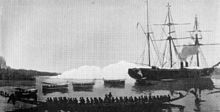
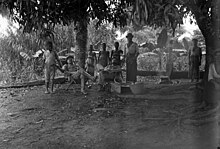
Scramble for Africa and German Kamerun (1884-1918)
The Scramble for Africa beginning in the late 1870s, saw European powers, primarily seeking to establish formal control over the parts of Africa not yet colonized. The Cameroon coast was of interest to both the British, already established in what is now Nigeria and with missionaries outposts in several towns, and the Germans who had extensive trading relationships and plantations established in the Douala region. On July 5, 1884, German explorer and administrator Gustav Nachtigal began signing agreements with Duala leaders establishing a German protectorate in the region. A brief conflict ensued with rival Duala chiefs which Germany and its allies won, leaving the British with little choice but to acknowledge Germany's claim to the region. The borders of modern Cameroon were established through a series of negotiations with the British and French. Germany established an administration for the colony with a capital first at Buea and later at Yaoundé and continued to explore the interior and co-opt or subjugate local rulers. The largest conflicts were the Bafut Wars and the Adamawa Wars which ended by 1907 with German victories.
Germany was particularly interested in Cameroon's agricultural potential and entrusted large firms with the task of exploiting and exporting it. German Chancellor Otto von Bismarck defined the order of priorities as follows: "first the merchant, then the soldier". It was under the influence of a businessman Adolph Woermann, whose company set up a trading house in Douala, that Bismarck, initially skeptical about the interest of the colonial project, was convinced. Large German trading companies (Woermann, Jantzen & Thormählen) and concession companies (Südkamerun Gesellschaft, Nord-West Kamerun Gesellschaft) established themselves massively in the colony. Letting the big companies impose their order, the administration simply supported them, protected them, and tried to eliminate indigenous rebellions.[10]
The Imperial German government made substantial investments in the
Shortly after the outbreak of
French Cameroon (1918-1960)
League of Nations Mandate, Free France, and UN Trust Territory

The French administration declined to return much of the property in Cameroon to its prior German owners, reassigning much of it to French companies. This was particularly the case for the Société financière des Caoutchoucs, which obtained plantations put into operation during the German period and became the largest company in French Cameroon. Roads and other infrastructure projects were undertaken with native labor, often in extremely harsh conditions. The Douala-Yaoundé railway line, begun under the German regime, was completed. Thousands of workers were forcibly deported to this site to work fifty-four hours a week. Workers also suffered from lack of food and the massive presence of mosquitoes and related illnesses. In 1925, the mortality rate on the site was 61.7%. However, the other sites were not as deadly, although working conditions were generally very harsh.[10]
French Cameroon joined the
Independence Movement
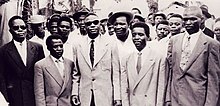
In 1948, the
An insurrection broke out among the
On 12 November 1958, France asked the United Nations to grant French Cameroon independence and end the Trusteeship. On 5 December 1958, the United Nations’ General Assembly took note of the French government's declaration according to which French Cameroon would gain independence on 1 January 1960.[15][16] On 13 March 1959, the United Nations’ General Assembly resolved that the UN Trusteeship Agreement with France for French Cameroon would end when French Cameroon became independent on 1 January 1960.[17]
British Cameroons (1918-1961)
Nigerian Administration

The British territory was administered as two areas,
When the
Plebiscite and Independence
French Cameroun became independent, as Cameroun or Cameroon, in January 1960, and Nigeria was scheduled for independence later that same year, which raised the question of what to do with the British territory. After some discussion (which had been going on since 1959), a
Independence and the Ahidjo era (1960-1982)


French Cameroon achieved independence on January 1, 1960. After Guinea, it was the second of France's colonies in Sub-Saharan Africa to become independent. On 21 February 1960, the new nation held a constitutional referendum, approving a new constitution. On 5 May 1960, Ahmadou Ahidjo became president. Ahidjo aligned himself closely with France and allowed many French advisers and administrators to stay on as well as leaving most of the country's assets in the hands of French companies.
Union with Southern Cameroons
On 12 February 1961, the results of the Southern Cameroon plebiscite were announced and it was learned that Southern Cameroons had voted for unification with the Republic Of Cameroon, sometimes called "reunification" since both regions had been part of German Kamerun. To negotiate the terms of this union, the
Civil War and repression
The UPC, which had demanded a full break with France and many of whom espoused
In 1966, opposition parties were banned and Cameroon became a
Discovery of oil
Cameroon became an oil-producing country in 1977. The accounting of oil revenues was totally opaque and many Cameroonians felt the money was mismanaged or embezzled since.[23] Oil remains a primary driver of the economy, though the country is not as oil-dependent as many other producers in the region.
Biya Era (1982-)

On 30 June 1975, Paul Biya, a long-serving bureaucrat and administrator in the Ahidjo government, was appointed Prime Minister. On November 4, 1982, Ahidjo resigned as president and Biya was his legal successor. Many observers were surprised, as Biya is a Christian from the south while Ahidjo was a Muslim from the North and Ahidjo was only 59 years old.[24] However, Ahidjo did not resign his role as leader of the governing party, and many speculated that he hoped Biya would be a figurehead, or perhaps even a temporary caretaker, as Ahidjo was rumored to be ill and receiving medical care in France.
Rift and coup attempt
Despite previous good relations, in 1983 a rift was apparent between Biya and Ahidjo. Ahidjo left for France and publicly accused Biya of abuse of power. Ahidjo sought to use his continuing control over the party apparatus to sideline Biya, by causing the party, not the President to set the government's agenda. However, at the party conference in September, Biya was elected to lead the party and Ahidjo resigned.[24] In January 1984, Biya was elected president of the country, running unopposed. In February, two senior officials were arrested and, along with Ahidjo who was tried in absentia alongside them.
On April 6, 1984, supporters of Ahidjo
Limnic eruptions

On August 15, 1984, Lake Monoun exploded in a limnic eruption that released enormous amounts of carbon dioxide, suffocating 37 people to death. On August 21, 1986, another limnic eruption at Lake Nyos killed as many as 1,800 people and 3,500 livestock. The two disasters are the only recorded instances of limnic eruptions, though geologic and sedimentary evidence indicates they may have caused large localized die-offs before historical records began.
Brief political loosening
Biya had initially seemed supportive of loosening restrictions on civil society, but the coup attempt ended any sign of opening up.[25] However, by 1990, pressure from Western governments was mounting as the end of the Cold War made them less tolerant of authoritarian allies. In December 1990, opposition parties were legalized for the first time since 1966. The first multiparty elections were held in 1992 and were hotly contested. Biya won with 40% of the vote against 36 for his closest competitor and 19 for another opposition party. In Parliament, Biya's ruling party on a plurality with 45% of the votes but failed to obtain a majority. The competitiveness of the election was not to Biya's liking and subsequent elections have been widely criticized by opposition parties and international observers as rigged and suffering from numerous and widespread irregularities. The ruling party has had no trouble gaining large majorities.
Pressure from Anglophone groups in former British Cameroons resulted in changes to the constitution in 1996, which purported to decentralize power but fell short of Anglophone demands to reestablish the federal structure. As a result of continued opposition, many of the changes adopted in 1996 have never been fully implemented and power remains highly centralized in the President.[25]
Bakassi border conflict
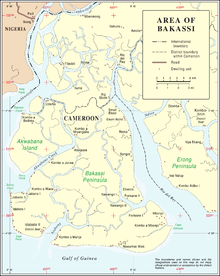
Bakassi is a peninsula on the Gulf of Guinea between the Cross River estuary and the Rio del Rey estuary on the east. The area was administered by Nigeria through the colonial era. However, after independence, efforts to demarcate the border revealed that a 1913 agreement between Britain and Germany, placed Bakassi in German Cameroon and accordingly should belong to Cameroon. Nigeria pointed to other colonial-era documents and agreements and their long history of administration to object to this narrative. The competing claims grew contentious after oil was discovered in the region. An agreement between the two countries in 1975 was derailed by a coup in Nigeria. In 1981, clashes between Nigerian and Cameroonian forces resulted in several deaths and nearly led to war between the two nations. The border saw further clashes several times throughout the 1980s. In 1993, the situation worsened with both countries sending large military contingents to the region and numerous reports of skirmishes and attacks against civilians. On 29 March 1994, Cameroon referred the matter to the International Court of Justice (ICJ).
In October 2002, the International Court of Justice ruled in favor of Cameroon. However, the ruling was resisted by Nigeria. Pressure from the UN and international community and the threat of withdrawal of foreign aid ultimately forced Nigeria to acquiesce and in 2006 the Greentree Agreement laid out a plan for the transfer of administration over two years. The transfer was successfully accomplished but many inhabitants of the peninsula retained their Nigerian citizenship and remain dissatisfied with the transition. Low-level violence continued until it was subsumed in the Anglophone Crisis in 2017.
2008 protests
In February 2008, Cameroon experienced widespread violent unrest as a strike by transport workers opposing high fuel prices and poor working conditions coincided with President Paul Biya's announcement that he wanted the constitution to be amended to remove term limits. Biya was scheduled to leave power at the end of his term in 2011. After several days of widespread rioting, looting, and reports of gunfire in all the major cities, calm was eventually restored after a crackdown with thousands arrested, and at least several dozen killed. The government announced lower fuel prices, increased wages for the military and civil servants, and decreased duties on key foodstuffs and construction materials. Many opposition groups reported additional harassment and restrictions on speech, gatherings, and political activity in the wake of the protests. Ultimately, the constitutional term limits were revoked and Biya was reelected in 2011 in an election criticized by the opposition and international observers as plagued by irregularities and low turnout.[26][27]
Contemporary issues
Boko Haram
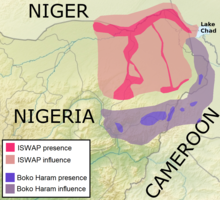
In 2014, the
Anglophone Crisis

In November 2016, major
Football
Cameroon has received some international attention following the relative success of its football team. The team has qualified for the FIFA World Cup eight times, more than any other African team. However, the team has only made it out of the group stage once, in 1990, when they became the first African team to reach the quarter-final of the World Cup. They have also won five Africa Cup of Nations.
See also
- Ambazonia
- History of Africa
- Politics of Cameroon
- List of heads of government of Cameroon
- List of heads of state of Cameroon
- Douala history and timeline
- Yaoundé history and timeline
References
- Background Note: Cameroon from the U.S. Department of State.
- Bullock, A. L. C. (1939). Germany's Colonial Demands, Oxford University Press.
- DeLancey, Mark W., and DeLancey, Mark Dike (2000): Historical Dictionary of the Republic of Cameroon (3rd ed.). Lanham, Maryland: The Scarecrow Press.
- Schnee, Heinrich (1926). German Colonization, Past and Future: The Truth about the German Colonies. London: George Allen & Unwin.
Notes
- ^ Cameroon (adj.)
- ^ Prentice, Alessandra (2024-01-22). "Cameroon launches routine malaria shots in global milestone". Reuters. Retrieved 2024-02-05.
- ^ Lavachery, Philippe (2001) The Holocene Archaeological Sequence of Shum Laka Rock Shelter (Grasslands, Western Cameroon). African Archaeological Review 18(4):213-247.
- ^ Cornelissen, Els (2003) On Microlithic Quartz Industries at the End of the Pleistocene in Central Africa: The Evidence from Shum Laka (NW Cameroon). African Archaeological Review 20(1):1-24.
- ^ ISBN 978-3937248141.
- ^ Hudgens & Trillo (1999), p. 1051.
- ^ DeLancey & DeLancey (2000), p. 237.
- ^ DeLancey & DeLancey (2000), p. 237; Walker (2011).
- ^ U.S. State Department. May 2002. Archived from the originalon June 6, 2002.
- ^ a b c d Thomas Deltombe, Manuel Domergue, Jacob Tatsita, Kamerun !, La Découverte, 2019
- ^ DeLancey and DeLancey 125.
- ^ DeLancey and DeLancey 226.
- S2CID 246004050.
- ^ Brady, Thomas F. (20 October 1958). "CAMEROONS GETS FREEDOM PLEDGE; Paris Backs Independence for African Trust Territory After Interim Self-Rule" – via NYTimes.com.
- ^ "From trusteeship to independence (1946–1960)". Archived from the original on 27 October 2012. Retrieved 2011-12-30.
- ^ "Question of the future of the Trust Territories of the Cameroons under French administration and the Cameroons under United Kingdom administration". undocs.org. United Nations. A/RES/1282(XIII). Retrieved 17 March 2017.
- ^ "The future of the Trust Territories of the Cameroons under French administration". undocs.org. United Nations. A/RES/1349(XIII). Retrieved 17 March 2017.
- ^ I.C.B Dear, ed, The Oxford Companion to World War II (1995) p 163
- ISBN 0-19-829645-2
- ^ Deutsche, Welle. "Cameroon: Colonial Past and Present Friction". DW.com. DW.
- ISBN 0-19-829645-2
- ^ Elections in Cameroon Archived 3 September 2011 at the Wayback Machine African Elections Database
- ^ Cowell, Alan (March 14, 1982). "As Oil Flows, Strains Come to Cameroon". New York Times. Retrieved 20 September 2021.
- ^ a b c Randal, Jonathan (April 15, 1984). "Tales of Ex-Leader's Role In Revolt Stun Cameroon". Washington Post. Retrieved 23 September 2021.
- ^ ISBN 978-0-8108-5824-4. Retrieved 23 September 2021.
- ^ "Turnout Low in Cameroon Presidential Poll". VOA. October 8, 2011. Retrieved 24 September 2021.
- ^ "Cameroon election deeply flawed, says US envoy". AFP. October 20, 2011. Retrieved 24 September 2021.
- ^ "Cameroon, Chad Deploy Troops to Fight Boko Haram – Nigeria". ReliefWeb. 26 May 2014. Retrieved 2014-06-10.
- ^ Kaze, Rennier (2014-06-06). "Dans le Nord du Cameroun, la "guerre" contre Boko Haram a commencé – Cameroon". ReliefWeb (in French). Retrieved 2014-06-10.
- ^ Boko Haram has been repelled, Cameroon's leader declares, CBC, Sep 30, 2018. Accessed Feb 6, 2019.
Works cited
- DeLancey, Mark W.; DeLancey, Mark Dike (2000). Historical Dictionary of the Republic of Cameroon (3rd ed.). Scarecrow Press. ISBN 978-0-8108-3775-1.
- Hudgens, Jim; Trillo, Richard (1999). The Rough Guide to West Africa (3rd ed.). Rough Guides.
- Walker, Robin (2011). When We Ruled: The Ancient and Mediæval History of Black Civilisations. Black Classic Press. ISBN 978-1-58073-045-7.
Further reading
- Ardener, Edwin. Kingdom on Mount Cameroon: Studies in the history of the Cameroon Coast, 1500-1970 (Berghahn Books, 1996) online.
- Arnold, Stephen. "Preface to a history of Cameroon literature in English." Research in African Literatures 14.4 (1983): 498-515 online
- Awasom, Nicodemus Fru. "The reunification question in Cameroon history: was the bride an enthusiastic or a reluctant one?" Africa Today (2000): 91-119. exccerpt
- DeLancey, Mark Dike, Mark W. DeLancey, and Rebecca Neh Mbuh. Historical dictionary of the Republic of Cameroon (Rowman & Littlefield, 2019). online
- Diduk, Susan. "European alcohol, history, and the state in Cameroon." African Studies Review 36.1 (1993): 1-42. doi.org/10.2307/525506
- Dupraz, Yannick. "French and British colonial legacies in education: Evidence from the partition of Cameroon." Journal of Economic History 79.3 (2019): 628-668. online
- Dze-Ngwa, Willibroad. "The First World War and its aftermath in Cameroon: A historical evaluation of a centenary, 1914-2014." International Journal of Liberal Arts and Social Science 3.2 (2015): 78-90. online
- Fowler, Ian. "Kingdoms of the Cameroon Grassfields." Reviews in Anthropology 40.4 (2011): 292-311.
- Fowler, Ian. "Tribal and palatine arts of the Cameroon grassfields: elements for a ‘traditional’ regional identity." in Contesting Art (Routledge, 2020) pp. 63-84.
- Fowler, Ian, and Verkijika G. Fanso, eds. Encounter, transformation and identity: peoples of the western Cameroon borderlands, 1891-2000 (Berghahn Books, 2009) online.
- Fowler, Ian, and David Zeitlyn, eds. African Crossroads: intersections between history and anthropology in Cameroon Berghahn Books, 1996) online
- Geschiere, Peter. "Chiefs and colonial rule in Cameroon: Inventing chieftaincy, French and British style." Africa 63.2 (1993): 151-175.
- Mengang, Joseph Mewondo. "Evolution of natural resource policy in Cameroon." Yale F&ES Bulletin 102 (1998): 239-248. online
- Njung, George N. "The British Cameroons mandate regime: The roots of the twenty-first-century political crisis in Cameroon." American Historical Review 124.5 (2019): 1715-1722.
External links
![]() Media related to History of Cameroon at Wikimedia Commons
Media related to History of Cameroon at Wikimedia Commons
- Map of German Cameroon (Kamerun) in 1914 at the Wayback Machine (archived 4 April 2013)
